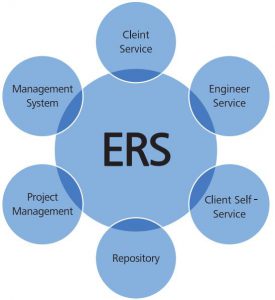SCS-ERS is an integrated operation system. The client service is powered by engineer service sub system, system management sub system, project management sub system, client self-service sub system and repository sub system. It constructs our integrated database platform and achieves the resource sharing, information sharing. Through the standard data format (such as the STEP data format), the system can work with most vessels’ ERS core calculation engine and could be compatible with most vessels’ ERS data, which means it could serve for most of the vessels.
When the registered ship might face emergency situation during operation such as in damage, grounding, fire, explosion etc., depending on the large on-shore based computer database system and the pre-established 3D model, SCS could provide rapid analysis and fast calculation of the vessel’s strength, stability and evaluate risk of the oil outflow. Through our integrated information platform, each part could share the information, it could not only help the fast assist in salvage, avoid huge property lost and the environmental destroy.
Main Functions of ERS
- Stability and strength of the vessel after damage and free floating
- Floating status of vessel after damage
- Stability in intermediate stages of flooding
- Danger of progressive flooding after damage
- Necessary tug capacity when grounded
- Estimate oil outflow
- Estimate the time for complete flooding after damage
- Navigability Report After Casualty
Benefits to Ship owner/operator
- Satisfy the requirement of ERS from Ministry of Transport of the People s Republic of China;
 Satisfy the requirement of OPA 90 , ISM , SMPEP and MARPOL ;
Satisfy the requirement of OPA 90 , ISM , SMPEP and MARPOL ;- Owner could enter scs-ers system to get the information of ships;
- Preventive management of operation risk;
- Emergency training and exercise;
- Obtain expert advice by minor cost;
- Lessen accident impact on business ( e . g . premium increase , credit damage , and legal cost ) and environment;
- Establish responsible image to safety to public;
- And enhance confidence in coping with crisis;
- Reduce owners economic losses caused by the ship in danger.


